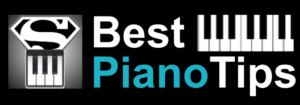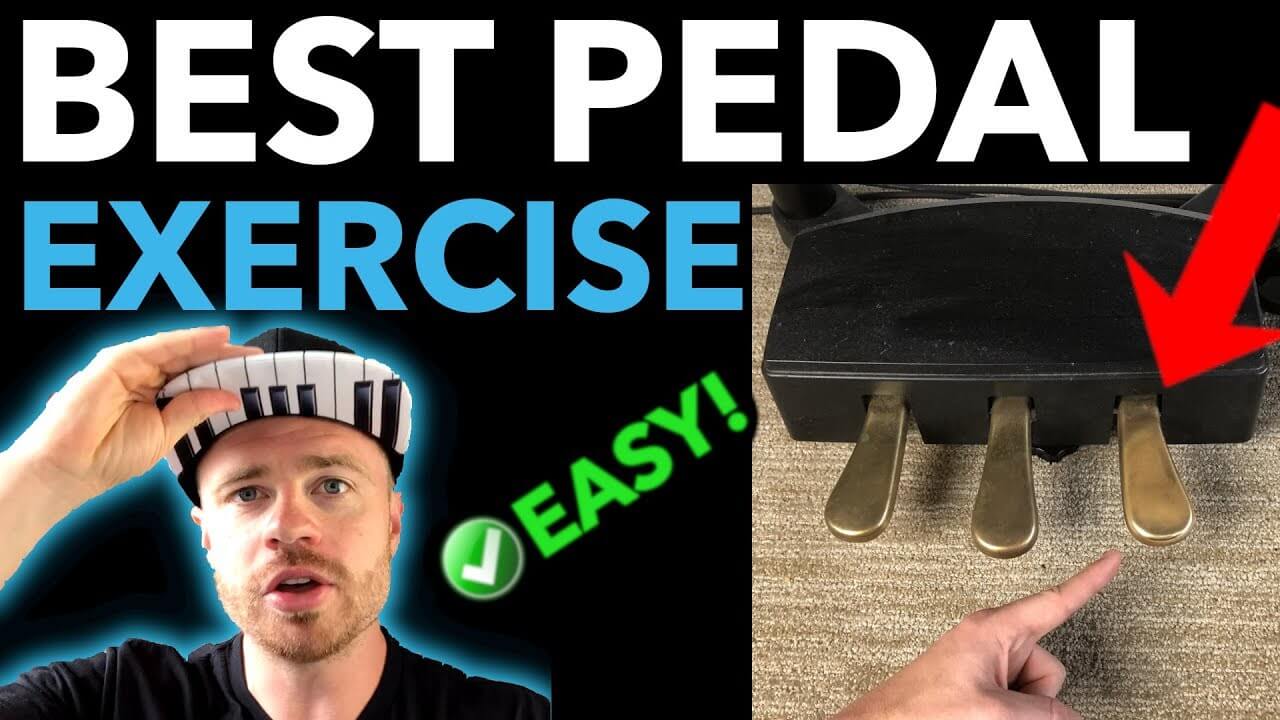Today you’ll learn a simple piano pedal exercise you can use to drill in pedaling to the point where you don’t even have to think about it.
First, I’m going to explain what the three pedals do.
Second, I’ll show you a 6-step exercise that’ll help you fully learn how to use the pedals.
Finally, you’ll learn about the biggest mistake beginners always make with pedals.
The Three Pedals
You’ll notice on most pianos there are three pedals, but two of them don’t really matter and we barely use them.
The pedal on the far left is called the “Soft Pedal” and when you push it down the notes, as you guessed, are softer. But if you want to play softer, you can just play the notes softer – you don’t have to use the pedal for this.
The middle pedal is called the “Sostenuto Pedal” and this is almost never used.
The pedal on the far right is the “Sustain Pedal” and this is what we use in 99.999% of the songs we’re going to play. A lot of pianos only come with one pedal nowadays because piano manufacturers realized that the Sustain Pedal is the only one people were actually using. So, if your piano only has one pedal, it is the Sustain Pedal.
The Sustain Pedal does exactly what it sounds like it does – it sustains the notes. If we hold down the pedal while we play, we’ll hear each note last longer, even after we let go of a note. The reason this is important is that it makes it a lot easier to play smoothly.
For example, let’s say I’m going from a C chord down to a G chord. To do this smoothly I’d have to move my hands really fast because I’d have to hold down the C chord then quickly play the G chord right after. There’s always going to be a little gap in between. However, with the Sustain Pedal, I can play the C chord, sustain it, and then take as much time as I need to find the G chord and play it.
Not only does the Sustain Pedal help it sound better, it also makes the piano a lot easier to play.
6-Step Exercise for Pedaling
Now for the most important part of this – the actual exercise to learn pedaling. A lot of teachers will show you how to pedal and what the pedal does, but they don’t teach you a progressive system to learn it. They just throw you into songs and this can really be frustrating for beginners.
“Both Down Up” Method
This is a great method for learning pedaling systematically to make it as easy as possible for you. Watch this video to hear exactly what the finished product should sound like. I’ll break down this process for you below.
Step one is to put your heel on the ground, just like you’d be driving a car, making sure you don’t lift your heel to play the pedal. With are hands we’re going to start in a C chord, C-E-G, and we’re going to stay there for the first step of this exercise.
We’re going to start out with our pedal down. The first movement is called “Both” and we’re going to, at the same time, lift our foot up and play our chord. Some people have trouble with this because our foot and hand are moving in opposite directions. If you’re struggling, imagine there is a rubber band between your foot and your hand connecting them and it brings them together.
Next, your foot goes back down and your hand goes back up.
The biggest mistake people make is forgetting to start with the pedal down. This is important!
For our next step we’re going to do the same thing, but the “both” and the “down” parts are going to be a lot quicker. It’s the exact same thing we did last time, but the both-down part is a lot faster.
Step three we’ll actually change chords. We’ll start at the C chord and then move to the Cadd9 chord. It’s the same thing but instead of a 3, we’re going to play a 2. We’re going to change between these chords and at the same time do our pedal thing. Again, watching this video will a big help for you as well.
For our fourth step we’re going to play 4 chords in a row before we change the pedal. We’re going to start the same way with the pedal down, and do our both-down-up and then we’re going to play three notes and just hold the pedal down and then we’re going to do the same thing.
The next step we’ll do the same thing we just did except add our new chord in there. We’re going to do it four times with the C chord and then four times with the Cadd9 chord.
Now you’re almost there and we’re just going to add the rest of the chord progression.
With this 6-step process you might not get through every single step on the first day. Maybe you can only get through the first three steps today, go to sleep, get through the first four steps, and then the next day you finish the entire process. That’s okay! It’s only a process the first time you do it. When you put it in a song the next time it’ll be a lot easier and by the time you get to 5 or 6 songs it’ll be where you’re doing it without even thinking about it.
The Biggest Mistake Beginner Piano Players Make
When using pedals, beginners will be playing a chord, and they’ll have the pedal down, but when they switch chords they’ll lift up too early on the pedal. That’s the biggest mistake beginners make.
Whenever you switch chords, that new chord you want to play it at the same time as lifting the pedal up. That’s really the big thing you need to watch out for when pedaling.
I hope you got a lot out of this!
If you’re really serious about learning piano, I do have a free Become a Piano Superhuman Course available which you should definitely check out.

